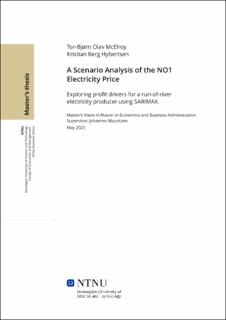| dc.description.abstract | Målet med denne masteroppgaven er å undersøke effekten av økt overføringskapasitet, høye naturgasspriser og lokale værvariabler (temperatur og nedbør) både på spotprisen for det norske budområdet NO1 og lønnsomheten til en representativ elvekraftprodusent, Glomma Kraftproduksjon AS (GKP) innenfor dette budområdet. For å besvare oppgaven ble det gjennomført en scenarioanalyse ved hjelp av en sesongbasert autoregressiv integrert glidende gjennomsnittsmodell med eksogene variabler (SARIMAX). Metoden involverte å konstruere en baseline-modell gjennom en prosess som inkluderte blant annet variabelvalg og parameterestimering, etterfulgt av scenarioer basert på oppgavens forskningsspørsmål.
For å vurdere effekten på lønnsomheten til GKP, ble siste kvartal av 2022 valgt for videre analyse. Det ble imidlertid observert at modellen hadde problemer med å fange opp den høye volatiliteten i datasettet for den perioden. Som en løsning på dette fokuserte evalueringen av modellen på hvor godt den fanget opp gjennomsnittlig spotpris over en tre-måneders periode, i stedet for å se på daglige svingninger.
Resultatene fra scenarioanalysen viste at økt importkapasitet gjennom NordLink- og North Sea Link kablene var den eneste eksogene variabelen med betydelig innvirkning på NO1-spotprisen, og dermed på lønnsomheten til GKP.
En tredobling av naturgassprisen i vårt andre scenario viste ingen tydelig innvirkning på NO1 spotprisen. For det tredje scenariet ble værvariablene temperatur og nedbør undersøkt. Vi så på to forskjellige scenarioer: "svært tørt og svært kaldt" og "svært vått og svært varmt". Imidlertid ble det ikke funnet noen korrelasjon mellom elektrisitetsprisen og disse værvariablene. Dette tyder på at variasjoner i temperatur og nedbør ikke hadde en betydelig innvirkning på spotprisen i NO1, i hvert fall innenfor rammene av denne studien.
Oppsummert fant studien at lokale værvariabler for NO1 hadde liten eller ingen innvirkning på NO1 spottprisen. Den fant også at importkapasitet hadde en sterk innvirkning på pris, men at naturgassprisene i Europa ikke påvirket NO1-prisen. Avslutningsvis var det interessant å oppdage at GKP har ingen innflytelse over prisen på varen den selger og svært begrenset kontroll over kostnader og dermed lønnsomheten. Imidlertid er vekst i importkapasitet og økende markedsintegrering med Europa til stor fordel, og medfører et svært lønnsomt scenario for GKP. | |
| dc.description.abstract | The aim of this master’s thesis is to investigate the impact of additional interconnector capacity, abnormally high natural gas prices, and local weather variables (temperature and precipitation) on both the spot price for the Norwegian bidding zone NO1 and profitability for a representative run-of-river hydropower producer in NO1, Glomma Kraftproduksjon AS (GKP). To answer the thesis, a scenario analysis was conducted with the use of a seasonal autoregressive integrated moving average with exogenous variables model (SARIMAX).
The methodology involved the process of creating a baseline model through a feature selection and parameter estimation process, followed by the creation of scenarios based on the thesis’s research questions.
In order to assess the impact on profitability for GKP, the last quarter of 2022 was selected for analysis. However, it was observed that the model struggled to capture the high volatility inherent in the dataset during that time period. As a remedy to this, the evaluation of the model focused on how well it captured the average spot price over the three-month period in place of the day-to-day fluctuations.
The results from the scenario analysis showed that an increase in additional import capacity through the NordLink and North Sea Link interconnectors was the only exogenous variable with any significant impact on the NO1 spot price and consequently on the profit generation of GKP.
Increasing the natural gas price by a factor of three for our second scenario found no evident impact on the NO1 Elspot price. For the third scenario, weather variables of temperature and precipitation were examined. We looked at two different scenarios: "dry and cold" and "wet and warm". However, no correlation was found between the electricity price and these weather variables. It suggests that the variations in temperature and precipitation did not have a significant impact on the electricity price in NO1, at least within the scope of this study.
In summary, the study found that local weather variables for NO1 had little to no impact on the NO1 Elspot price. It also found that import interconnector capacity had a strong impact on price, but that natural gas prices in Europe did not show any impact on the NO1 price. Finally, GKP has no influence over the price of the commodity it sells and very limited control over its cost and, therefore, its profitability. However, interconnector capacity growth and increasing market integration with Europe are of great benefit and, according to this study period, result in a highly profitable scenario outcome for GKP. | |
